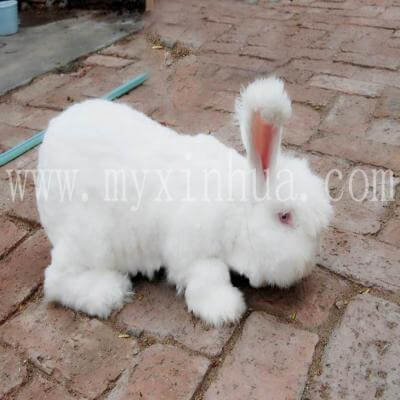


長毛兔的病癥怎么判斷?
 發布日期:2025-02-10
來源:http://www.uying888.com 發布人:創始人
發布日期:2025-02-10
來源:http://www.uying888.com 發布人:創始人
長毛兔的病癥可以從其外觀表現、行為狀態、生理機能等多個方面進行判斷,以下是具體介紹:
The symptoms of long haired rabbits can be judged from multiple aspects such as their appearance, behavioral status, and physiological functions. The following is a specific introduction:
外觀方面
In terms of appearance
皮毛
coat
掉毛異常:如果發現長毛兔大量掉毛,且不是正常的換毛期,可能是患有皮膚真菌病、螨蟲病等皮膚病,或者是營養缺乏、應激等原因引起。比如感染疥螨時,兔子會因瘙癢而啃咬、摩擦皮膚,導致局部掉毛。
Abnormal hair loss: If a large amount of hair loss is found in long haired rabbits, and it is not the normal shedding period, it may be caused by skin diseases such as fungal and mite diseases, or nutritional deficiencies, stress, and other reasons. For example, when infected with scabies mites, rabbits may bite and rub their skin due to itching, resulting in local hair loss.
毛發粗糙無光澤:可能是營養不良,如缺乏蛋白質、維生素、礦物質等,也可能是患有慢性疾病,如消化道疾病導致營養吸收不良。
Rough and dull hair: It may be due to malnutrition, such as lack of protein, vitamins, minerals, etc., or chronic diseases, such as digestive tract diseases leading to poor nutrient absorption.
眼睛
eye
流淚、紅腫:可能是眼部感染,如結膜炎,通常由細菌、病毒感染或外傷引起。也可能是兔舍內氨氣濃度過高刺激眼睛導致。
Tears and redness: It may be an eye infection, such as conjunctivitis, usually caused by bacterial or viral infections or trauma. It may also be caused by high ammonia concentration in the rabbit house, which irritates the eyes.
有眼屎:正常情況下兔子眼屎較少,如果眼屎增多且呈膿性,可能是眼部有炎癥,或者是全身性感染疾病在眼部的表現。
Having eye droppings: Under normal circumstances, rabbits have less eye droppings. If there is an increase in purulent eye droppings, it may be due to inflammation in the eyes or the manifestation of systemic infectious diseases in the eyes.
耳朵
Ears
耳朵下垂:正常的長毛兔耳朵應該是豎立的,如果耳朵下垂,可能是耳朵受傷、患有中耳炎,或者是感染了耳螨。
Ear droop: Normal long haired rabbit ears should be upright. If the ears droop, it may be due to ear injury, otitis media, or infection with ear mites.
耳部有結痂:耳螨感染時,耳朵內會出現白色或黃色的結痂和分泌物,兔子會頻繁搖頭、撓耳。
Ear scabs: When infected with ear mites, white or yellow scabs and secretions will appear inside the ears, and rabbits will frequently shake their heads and scratch their ears.
口腔
oral cavity
流口水:可能是口腔炎、口腔潰瘍,或者是牙齒過長、咬合不正等問題。口腔炎常由細菌感染、維生素缺乏等引起,患病兔子口腔黏膜會出現紅腫、潰瘍。
Drooling: It may be caused by oral inflammation, oral ulcers, or problems such as long teeth or misaligned bite. Oral inflammation is often caused by bacterial infection, vitamin deficiency, etc. In diseased rabbits, the oral mucosa may become red, swollen, and ulcerated.
口臭:可能是口腔衛生不良,食物殘渣在口腔內發酵,也可能是消化系統疾病導致。
Bad breath: It may be caused by poor oral hygiene, food residues fermenting in the mouth, or digestive system diseases.
行為表現
Behavioral performance
精神狀態
mentality
精神萎靡:正常的長毛兔比較活潑,對外界刺激有反應。如果兔子精神不振,嗜睡,對周圍環境不感興趣,可能是生病了,比如感染了細菌、病毒等病原體引發全身性疾病。
Mental lethargy: Normal long haired rabbits are more lively and responsive to external stimuli. If a rabbit is lethargic, drowsy, and uninterested in its surroundings, it may be sick, such as being infected with bacteria, viruses, and other pathogens that can cause systemic diseases.
異常興奮:如出現無規律的奔跑、跳躍、轉圈等行為,可能是腦部疾病、寄生蟲感染,或者是中毒引起的神經系統癥狀。
Abnormal excitement: If there is irregular running, jumping, spinning and other behaviors, it may be a neurological symptom caused by brain disease, parasitic infection, or poisoning.
采食與飲水
Eating and drinking water
食欲不振:可能是口腔、腸胃等部位有疾病,如口腔炎導致采食疼痛,腸胃炎引起消化功能紊亂。也可能是環境溫度過高或過低、飼料變質等原因。
Loss of appetite: It may be caused by diseases in the oral cavity, gastrointestinal tract, and other areas, such as pain during feeding due to oral inflammation, and digestive dysfunction due to gastroenteritis. It may also be due to high or low ambient temperatures, spoiled feed, or other reasons.
飲水量異常:如果長毛兔飲水量突然增加,可能是天氣炎熱、飼料過干,也可能是患有糖尿病、腎臟疾病等。相反,飲水量減少可能是病情嚴重,身體極度虛弱的表現。

Abnormal water consumption: If the water consumption of the angora rabbit suddenly increases, it may be because of hot weather, too dry feed, or diabetes, kidney disease, etc. On the contrary, a decrease in water intake may be a sign of severe illness and extreme physical weakness.
運動姿態
Movement posture
跛行:可能是腿部受傷、骨折,或者是關節疾病,如關節炎、痛風等。也可能是腳部感染,如腳皮炎,導致兔子不敢用力著地。
Liming: It may be a leg injury, fracture, or joint disease such as arthritis, gout, etc. It could also be a foot infection, such as foot dermatitis, causing the rabbit to be afraid to land hard.
行動遲緩:除了可能是骨骼肌肉問題外,也可能是全身性疾病導致身體虛弱,如嚴重的寄生蟲感染、慢性消耗性疾病等。
Slow movement: In addition to skeletal and muscle problems, it may also be caused by systemic diseases leading to physical weakness, such as severe parasitic infections, chronic wasting diseases, etc.
生理機能
physiological function
體溫:正常長毛兔的體溫在 38.5℃-39.5℃之間。如果體溫高于或低于這個范圍,可能是生病了。體溫升高常見于感染性疾病,如兔瘟、巴氏桿菌病等;體溫過低可能是嚴重的營養不良、低溫環境凍傷,或者是疾病晚期身體機能衰竭。
Body temperature: The normal body temperature of a long haired rabbit is between 38.5 ℃ and 39.5 ℃. If the body temperature is above or below this range, it may indicate illness. Elevated body temperature is common in infectious diseases, such as rabbit plague, pasteurellosis, etc; Low body temperature may indicate severe malnutrition, frostbite in low-temperature environments, or late stage physical dysfunction.
呼吸
breathing
呼吸急促:可能是呼吸系統疾病,如肺炎、胸膜炎等,也可能是中暑、心臟疾病等導致。運動后或環境溫度過高時呼吸也會加快,但休息或降溫后會恢復正常,如果持續呼吸急促則是異常情況。
Shortness of breath: It may be caused by respiratory diseases such as pneumonia, pleurisy, or heat stroke, heart disease, etc. After exercise or when the ambient temperature is too high, breathing will also accelerate, but it will return to normal after rest or cooling down. If breathing continues to be rapid, it is an abnormal situation.
呼吸困難:除了呼吸道疾病外,還可能是胸腔積液、氣胸等胸部疾病,或者是貧血、中毒等全身性疾病影響了氧氣的運輸和利用,患病兔子可能會出現張口呼吸、鼻翼扇動等癥狀。
Dyspnea: In addition to respiratory diseases, it may also be chest diseases such as pleural effusion and pneumothorax, or systemic diseases such as anemia and poisoning that affect the transportation and utilization of oxygen. Infected rabbits may experience symptoms such as mouth opening breathing and nasal wing flapping.
糞便
faeces
腹瀉:糞便稀軟、不成形或呈水樣,可能是飲食不當,如采食了變質飼料、飲水不潔,也可能是腸道感染,如大腸桿菌病、沙門氏菌病等。
Diarrhea: Soft, unformed or watery stool, which may be due to improper diet, such as consuming spoiled feed, drinking unclean water, or intestinal infections such as Escherichia coli and Salmonella.
便秘:表現為糞便干結、量少,兔子排便困難,可能是飼料中纖維含量過低、飲水不足,或者是腸道梗阻、腸道蠕動功能減弱等原因。
Constipation: manifested as dry and insufficient stool, difficulty in defecation in rabbits, which may be due to low fiber content in feed, insufficient drinking water, or intestinal obstruction, weakened intestinal peristalsis function, and other reasons.
本文由長毛兔友情奉獻.更多有關的知識請點擊: http://www.uying888.com真誠的態度.為您提供為的服務.更多有關的知識我們將會陸續向大家奉獻.敬請期待.
This article is a friendly contribution from Long haired Rabbit For more information, please click: http://www.uying888.com Sincere attitude To provide you with comprehensive services We will gradually contribute more relevant knowledge to everyone Coming soon.